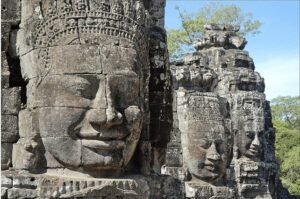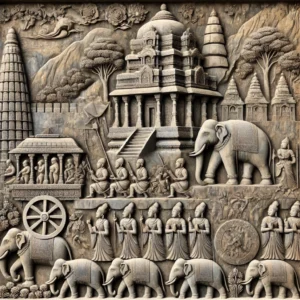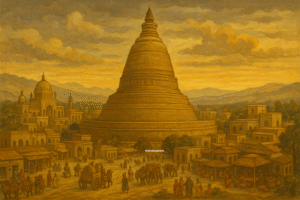Origins and Background
The Delhi Sultanate (1206–1526 CE) was a Muslim kingdom that ruled large parts of the Indian subcontinent. It was established after the defeat of Prithviraj Chauhan at the hands of Muhammad Ghori in the Second Battle of Tarain (1192 CE). Ghori’s general, Qutb-ud-din Aibak, became the first ruler of the Sultanate in 1206 CE, marking the beginning of Islamic rule in India.

The Delhi Sultanate was primarily ruled by Turkic and Afghan dynasties, who came from Central Asia and Persia, bringing with them Islamic traditions, military strategies, and administrative systems. Their rule profoundly impacted the cultural, political, and religious landscape of India, often through violent means.
The Dynasties of the Delhi Sultanate
The Delhi Sultanate was ruled by five major dynasties:
- Mamluk (Slave) Dynasty (1206–1290 CE)
- Founded by Qutb-ud-din Aibak, a former slave of Muhammad Ghori.
- Consolidated Muslim rule in Northern India and initiated the construction of the Qutb Minar.
- Faced internal conflicts and Mongol invasions.
- Khalji Dynasty (1290–1320 CE)
- Established by Jalal-ud-din Khalji, later dominated by Alauddin Khalji.
- Expanded the Sultanate to the Deccan through brutal military campaigns.
- Introduced market control policies and maintained a strong military against Mongol invasions.
- Tughlaq Dynasty (1320–1414 CE)
- Founded by Ghiyas-ud-din Tughlaq and reached its peak under Muhammad bin Tughlaq.
- Known for ambitious but often failed projects like the transfer of capital from Delhi to Daulatabad.
- Faced internal revolts and external invasions, weakening the empire.
- Sayyid Dynasty (1414–1451 CE)
- A relatively weak dynasty that struggled to maintain control over the empire.
- Mostly served as puppet rulers under Mongol and Afghan pressures.
- Lodi Dynasty (1451–1526 CE)
- Founded by Bahlul Lodi, an Afghan warlord.
- The last ruler, Ibrahim Lodi, was defeated by Babur in 1526 CE, marking the beginning of the Mughal Empire.
Brutality and Oppression
The Delhi Sultanate was notorious for its military conquests, massacres, and religious persecution. Key events of brutality include:
- Destruction of Hindu temples and forced conversions under various sultans.
- The massacre of Rajput warriors in Chittorgarh during Alauddin Khalji’s reign.
- Muhammad bin Tughlaq’s disastrous tax policies, which led to famines and revolts.
- Tamerlane’s invasion of Delhi in 1398 CE, which resulted in a mass slaughter of Hindus and destruction of the city.

Policies and Governance
Despite the violence and religious persecution, the Delhi Sultanate introduced several important administrative changes. Persian was made the official language of governance, and the use of Islamic law (Sharia) influenced legal and social structures. The sultans promoted trade, particularly with the Middle East and Central Asia, leading to economic growth in urban centers like Delhi and Lahore.
- Introduction of Persian as the official language of administration.
- Implementation of Islamic law (Sharia) in governance, often marginalizing Hindu customs.
- Introduction of Jizya (tax on non-Muslims), making life difficult for Hindus and other indigenous communities.
- Expansion of trade and urbanization, especially under the Tughlaqs and Khaljis.
Market regulation policies under Alauddin Khalji controlled prices and prevented hoarding, while the Tughlaqs introduced coinage reforms and attempts at centralized taxation. However, heavy taxation, forced labor, and the rigid enforcement of Islamic law alienated many sections of the population, leading to frequent uprisings.
Impact on Indian Society and Colonization
The Delhi Sultanate laid the groundwork for Islamic rule in India and introduced elements of Persian, Central Asian, and Arabic cultures. However, this period also saw:
- The systematic destruction of Hindu and Buddhist religious institutions.
- The imposition of a foreign Islamic ruling elite over the indigenous population.
- The spread of Islam through both forced and voluntary conversions.
- The introduction of Persian art, literature, and architecture, influencing later Mughal developments.
- The emergence of Indo-Islamic architecture, exemplified by structures such as the Qutb Minar and Alai Darwaza.
- Advancements in trade and economy, with an increase in commercial interactions between India and the Middle East.
- The development of the Urdu language, blending elements of Persian, Arabic, and local dialects, which would later become a significant linguistic legacy.
The Sultanate played a key role in introducing Islamic architecture, Persian literary traditions, and new agricultural techniques to India. The emergence of Indo-Islamic architecture, seen in structures like the Qutb Minar, Alai Darwaza, and Tughlaqabad Fort, reflects the fusion of Persian, Turkic, and Indian influences. Additionally, the period saw the development of Urdu, a language that blended elements of Persian, Arabic, and native dialects.
Trade flourished during this time, with Delhi becoming an important hub for artisans and merchants. However, the rigid enforcement of Islamic rule and discriminatory policies towards non-Muslims led to tensions and resistance from local communities, sowing the seeds for future conflicts.
End of the Delhi Sultanate
The decline of the Delhi Sultanate was caused by internal weaknesses, administrative failures, and external invasions:
- Corruption and incompetence among later rulers.
- Frequent internal rebellions by provincial governors and local Hindu rulers.
- Mongol and Timurid invasions, weakening the Sultanate.
- The rise of regional powers like the Vijayanagara Empire and the Bahmani Sultanate.
The final blow came in 1526 CE when Babur, a descendant of Timur and Genghis Khan, defeated Ibrahim Lodi in the First Battle of Panipat. This marked the beginning of the Mughal Empire, which would dominate India for the next three centuries and significantly alter its political and cultural landscape.
The Delhi Sultanate was a complex and often ruthless period in Indian history. It introduced new administrative policies, architectural styles, and economic structures, but at the cost of widespread violence, religious intolerance, and colonial-style governance. Its legacy remains deeply controversial, representing both a period of foreign domination and lasting cultural exchange. While it brought centralization and military organization, it also left behind a history of persecution, conflict, and societal upheaval. The transition to the Mughal era marked the beginning of a more structured, yet equally transformative period in Indian history.






